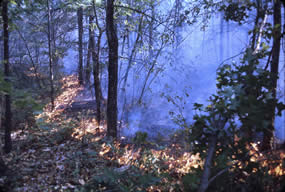 |
| Bacon Fire |
 |
Fire regime describes the pattern of fire occurrence in a particular ecosystem or geographic area. It is described in terms of the size, severity, type, and frequency of fire that is characteristic of the location or ecosystem. The fire regime at ShenandoahNational Park is a mixed fire regime, because the three major forest types each have different fire regimes. Shenandoah is almost entirely forested. Most of those forests fall into one of three major groups: mixed mesic hardwood forest, mixed oak forest, and mixed pine-oak forest. The mixed mesic hardwood forest is characterized by large, severe surface fires at long intervals of 250 to 500 years. The plant species tend to be shade-tolerant and are usually damaged by fire. The mixed oak forest is characterized by small, low-severity surface fires at 10- to 35-year intervals. The plants are a mix of shade-tolerant and sun-loving species, and the characteristic oak species need fire to keep the canopy open to allow sunlight to penetrate to the forest floor species. The mixed pine-oak forest has a truly mixed fire regime, because it combines the same fires the affect the mixed oak forest with large, high-severity crown fires at moderate intervals of 50 to 100 years. The majority of the plant species are sun-loving and some species, such as pitch pine and Table Mountain Pine, are fire-dependent, which means that they require fire every so often in order to reproduce. Historically, some fires were ignited by lightning but most of the small, low-severity fires were ignited, on purpose or by mistake, by Native Americans and Euro-American settlers.
For information about specific managed fires in Shenandoah click here.
Related Information
Websites that provide helpful information about fire ecology are:
National Wildfire Coordinating Group – Fire Ecology Website Index
Listing of these websites does not and is not intended to imply endorsement by the National Park Service of commercial services or products associated with the sites.
|






